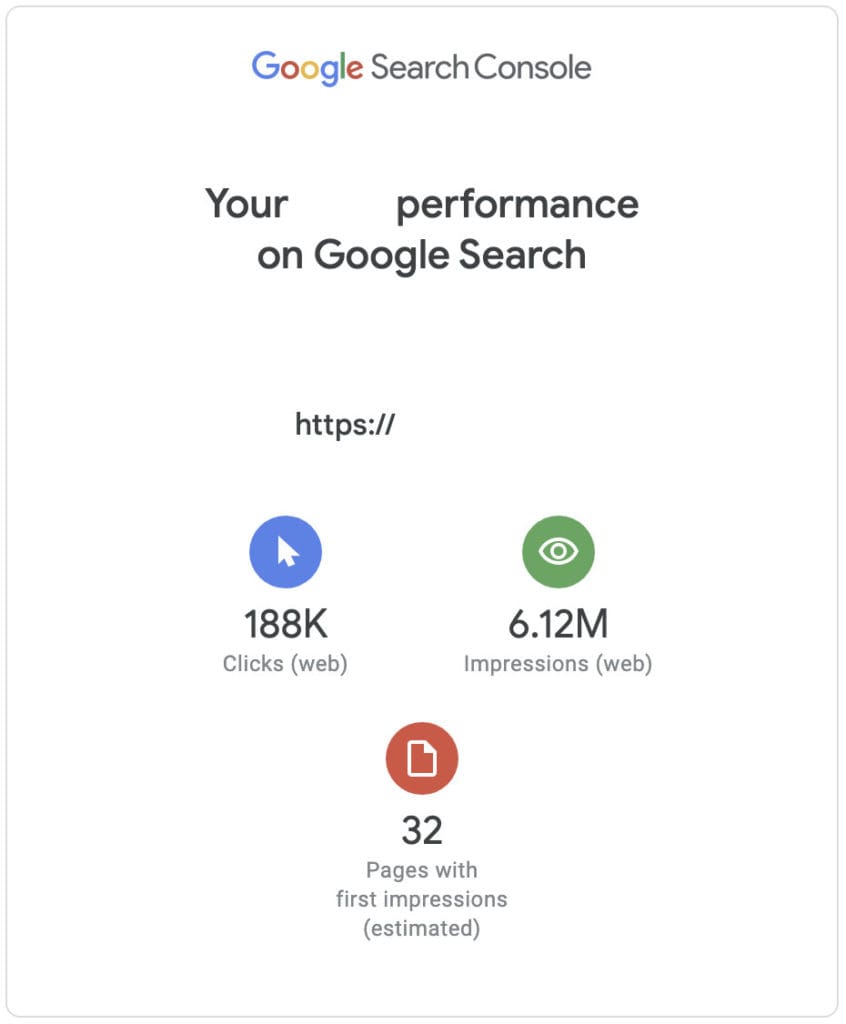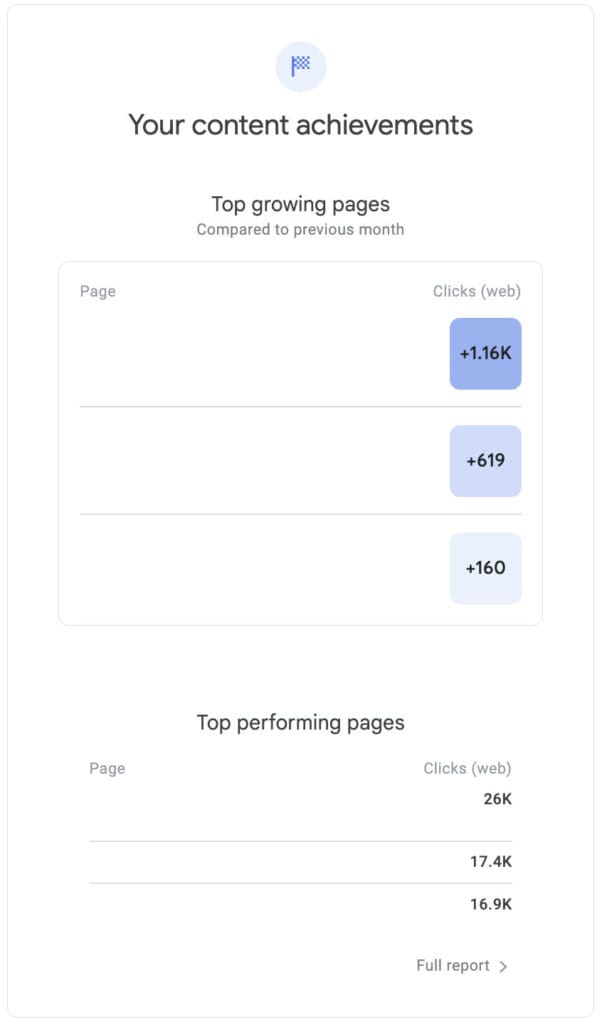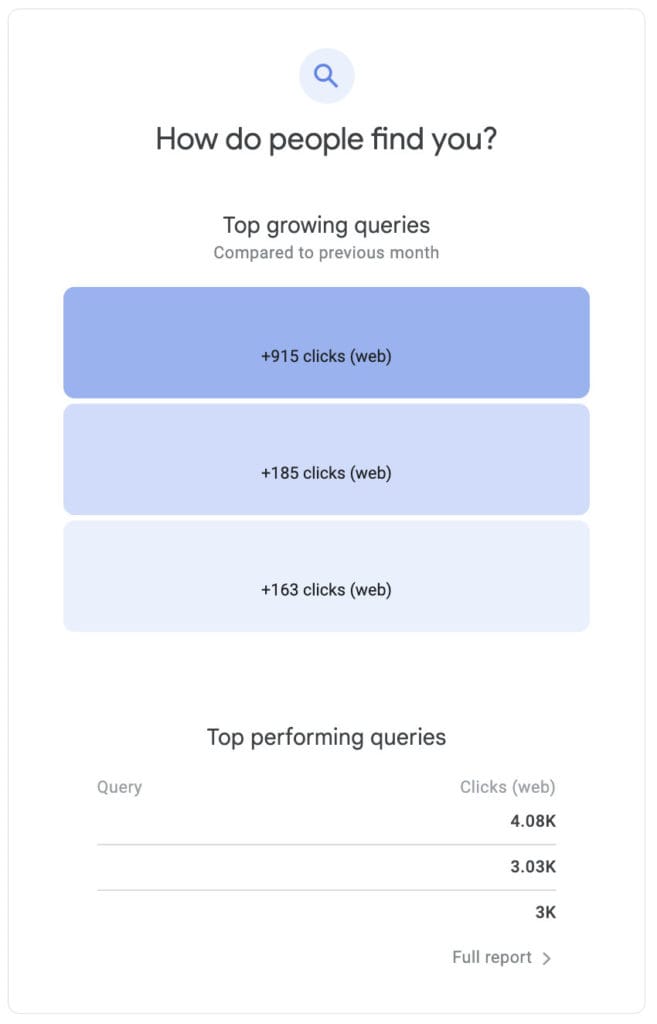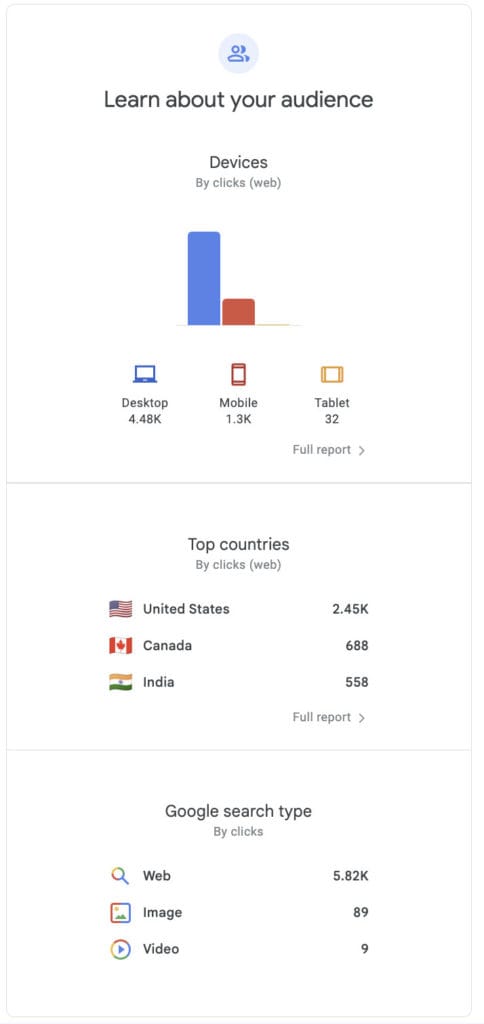Understanding the Google Search Console Report Email: A Primer for Beginners
Google Search Console is an indispensable tool for site owners; unlike Google Analytics, which shows you what traffic looks like once it’s on your site, Google Search Console shows a window into your website’s performance within Google’s search results. Among its features, the Performance Report Email is particularly noteworthy. It serves a wealth of data on your site’s visibility and engagement through organic search. Here’s a detailed look at the critical elements of this report.
Table of Contents
- Your {Month} performance on Google Search
- Your content achievements
- How do people find you?
- Learn about your audience
- Diving deeper into Google Search results
Introduction to Google Search Console
What is Google Search Console?
Google Search Console (GSC) is a free tool provided by Google that helps website owners and SEO professionals monitor and maintain their website’s presence in Google search results. Unlike Google Analytics, which focuses on user behavior once they are on your site, GSC provides insights into how Google indexes your website and how it performs in search results. It identifies problems, offers suggestions for improvement, and helps you understand how users interact with your site through search queries. Using GSC, you can optimize your website to achieve better search engine rankings and enhance its visibility in Google search.
Benefits of using Google Search Console for SEO
Using Google Search Console can significantly enhance your SEO efforts. It provides a wealth of data on how your website performs in search results, helping you identify areas for improvement and optimize your site for better search engine rankings. With GSC, you can analyze search queries to understand what terms users use to find your site, evaluate page performance to see which pages drive traffic, and gain insights into user behavior. Additionally, GSC helps you identify and fix technical issues, such as crawl errors and mobile usability problems, which can negatively impact your search engine rankings. By leveraging these insights, you can create more compelling content and marketing strategies, ultimately driving organic traffic to your site.
How to set up Google Search Console
Setting up Google Search Console is a straightforward process. Follow these steps to get started:
- Create a Google account: If you don’t already have one, create a Google account.
- Sign in to Google Search Console: Go to the Google Search Console website and sign in with your Google account.
- Add your property: Click on “Add a property” and enter your website’s URL.
- Verify your website ownership: Google offers several methods to verify your website's ownership. You can upload an HTML file to your website’s root directory, add a meta tag to your website’s homepage, or use Google Analytics or Google Tag Manager for verification.
- Access your data: Once your website is verified, you can access a wealth of data about your site’s performance in Google Search Console.
By setting up GSC, you gain access to valuable insights that can help you optimize your website for better performance in Google search results.
Your {Month} performance on Google Search
At the outset, the report presents an overview of your site’s organic search metrics for the month, which include:

- Clicks (Web): This figure represents the number of clicks your site has garnered, precisely the number of times users clicked on your site’s pages from Google search results.
- Impressions: A measure of your site’s visibility, reflecting how often your pages appeared in Google search results.
- Pages with First Impressions: This metric highlights new visibility, indicating the pages that appeared in Google search results for the first time.
The average position metric provides insights into your pages' average ranking over time, helping you understand fluctuations in search performance.
Understanding these core metrics is foundational. Now, let’s explore other insightful aspects of the report.
Monitoring your search performance through these metrics is crucial for identifying areas for improvement and optimizing your SEO strategies.
Your content achievements
This section of the report shows a closer look at your site’s content performance, with a focus on:

- Top Growing Pages: Identify pages with a notable uptick in total clicks, shedding light on potential drivers like recent events, media appearances, or content trends. Examples:
- If your homepage is listed here, ask yourself: What changed? Did your team make a podcast appearance? Was there a notable product launch? Perhaps a spree of networking at conferences? Such events often drive brand awareness.
- For a career page, a surge might be linked to new job postings.
- Knowledge-based content? It might indicate an improved keyword ranking or a trending topic.
- Top Performing Pages: This section captures the most clicked pages for the month. While these metrics might seem consistent, keep looking for spikes—these could be tied to trending brand content or a piece gaining traction.
Examining the performance of each specific page can provide deeper insights into what content resonates most with your audience.
A deeper exploration through the “Full Report” link can offer more granular insights, especially when examining specific pages and date ranges.
How do people find you?
The core of your online visibility lies in the search queries that lead users to your site. This section breaks down:
Understanding which search result pages drive traffic can help you optimize your content to match user intent better.

- Top Growing Queries: Uncover search terms that have gained momentum and are potentially influenced by brand activities or broader trends.
- Branded Activities: Surges in specific branded queries often align with initiatives to boost brand visibility. This could be because of a recent PR campaign, event sponsorship, leadership speaking engagements, or even appearances on popular podcasts.
- Non-branded: The growth in these search terms often indicates:
- A broader audience seeking information on a trending topic or industry development.
- Achievements in SEO practices, perhaps capturing a wider audience due to better search rankings. When you see this trend, it’s a green light to delve deeper. What modifications contributed to this SEO win? And more importantly, how can these successful tactics be replicated for other content?
- Branded: As mentioned, these are intrinsically linked to brand-centric actions that fortify your brand’s position in the relevant searches.
- Top Performing Queries: Highlight the search terms driving the most traffic, offering insights into successful content and SEO strategies.
- Branded: As mentioned, these are intrinsically linked to brand-centric actions that fortify your brand’s position in the relevant searches.
- Non-branded: Peaks in these areas can result from:
- Evolving interests or emerging trends in your industry.
- Certain web pages have seen a leap in search rankings. Spotting this means it’s time to revisit and possibly replicate the strategies that catalyzed such growth.
This analysis reveals what attracts users and provides strategic insights for optimizing your content and SEO efforts.
Learn about your audience
Gain valuable demographic and behavioral insights into your audience, including:

- Devices: Understand the preferred devices of your visitors, guiding your optimization priorities.
- Top Countries: See where your audience is geographically concentrated, informing potential market expansion strategies.
- Search Type: Break down the types of Google searches driving traffic to your site, allowing for targeted optimization strategies.
- Web: The conventional Google search.
- Image: Have you noticed a surge in image search traffic? Check which images rank well and optimize them. Consider filename, alt text, and design tweaks, like adding color to distinguish your image from monochromatic search results.
- Video: Significant video query traffic? Review and optimize the video presentation in search results, including the thumbnail, title, and description.
- News: For those seeking prominence in Google News, ensuring high-quality content and aligning with Google News content policies is essential.
Knowing how many pages are indexed by Google can help you understand the scope of your site’s visibility.
These insights are crucial for refining your SEO strategies and enhancing user experiences.
Diving deeper into Google Search Console
While the Google Search Console summarizes your site’s performance in its emails, the actual depth of its offerings can only be unlocked by logging into the platform itself. This next logical step opens up a wealth of detailed analytics and features not covered in the email summaries. Inside Google Search Console, you’ll find extensive data on aspects like search appearance, structured data’s impact on your site, core web vitals, mobile usability, and much more. Here, you can dig into how your site interacts with Google Search, enabling a deeper analysis and more strategic optimizations for your online presence. Analyzing the performance of each web page can help you understand visitor engagement and optimize your SEO strategies. It includes:
- Google Search Console Links and URL Inspection Tool: These features help you understand how Google views your site, from indexed pages to external links and the relevance of specific pages.
- Structured Data and Search Appearance: Analyze how structured data impacts your site’s presentation in search results, including rich results and AMP pages.
- Core Web Vitals Data and Mobile Usability: These metrics provide insights into the user experience and highlight areas for improvement on mobile devices and desktops.
- Coverage Report and Request Indexing: Understand the coverage of your site’s pages in Google’s index and take action to request indexing for new or updated content.
- Manual Actions and Security Issues: Stay informed about any manual actions taken by Google or security issues that need addressing to maintain your site’s integrity in search results.
By weaving these elements into your analysis, you’ll gain a comprehensive understanding of your site’s performance in Google search. This will enable informed decisions to enhance visibility, engagement, and success in the digital landscape.
Troubleshooting Common Issues
Common problems and their solutions in the Performance Report
The Performance Report in Google Search Console is a powerful tool for identifying issues that may be affecting your website’s search engine rankings. Here are some common problems and their solutions:
- Low click-through rate (CTR): A low CTR can indicate that your website’s title tags and meta descriptions are not compelling enough to entice users to click through to your site.
- Solution: Review and optimize your title tags and meta descriptions to make them more descriptive and attention-grabbing. Ensure they accurately reflect the content of your pages and include relevant keywords.
- High bounce rate: A high bounce rate can suggest that users are not finding what they’re looking for on your website.
- Solution: Review your website’s content and user experience to ensure it is relevant and engaging to your target audience. Consider improving the quality of your content, enhancing page layout, and ensuring that your site is easy to navigate.
- Slow page speed: Slow page speed can negatively impact both search engine rankings and user experience.
- Solution: Optimize your website’s images, minify CSS and JavaScript files, and leverage browser caching to improve page speed. Tools like Google PageSpeed Insights can provide specific recommendations for speeding up your site.
- Mobile usability issues: Mobile usability issues can affect your search engine rankings and user experience, especially as more users access the web via mobile devices.
- Solution: Ensure that your website is mobile-friendly and responsive. Use the Mobile Usability report in GSC to identify and fix any issues, such as text that is too small to read or clickable elements that are too close together.
- Structured data errors: Structured data errors can prevent search engines from understanding your website’s content and context, which can impact your search appearance.
- Solution: Review and fix any structured data errors identified in the Performance Report. Ensure that your website’s schema markup is accurate and up-to-date, and use Google’s Structured Data Testing Tool to validate your structured data.
By addressing these common issues, you can improve your website’s performance in Google search results and provide a better experience for your users.